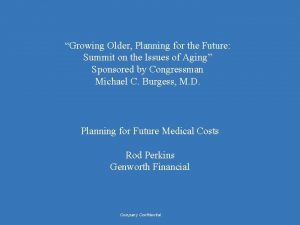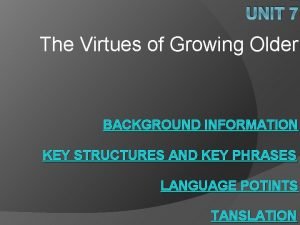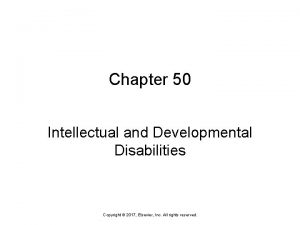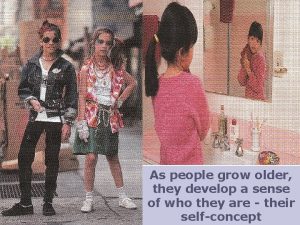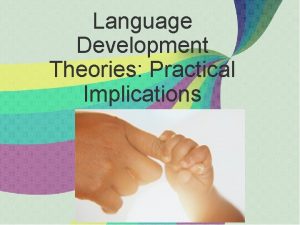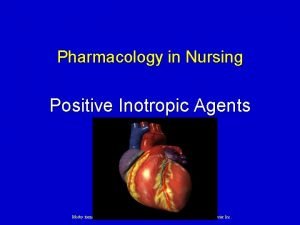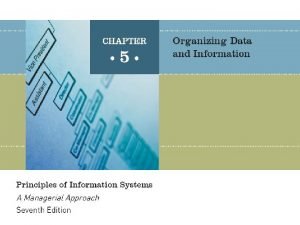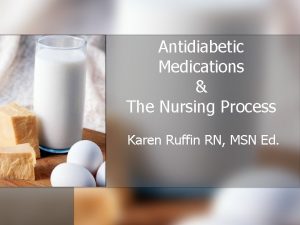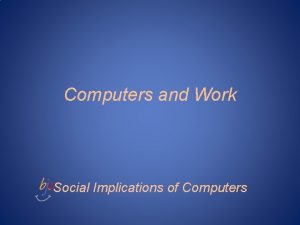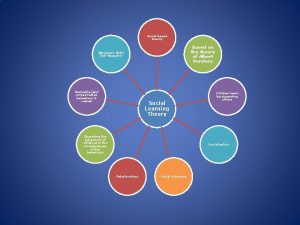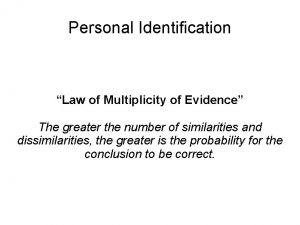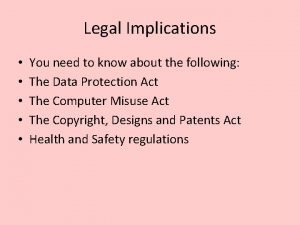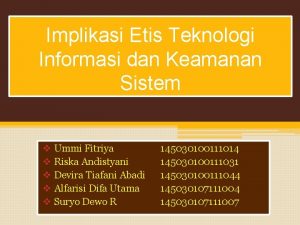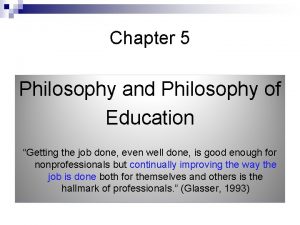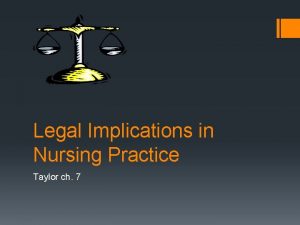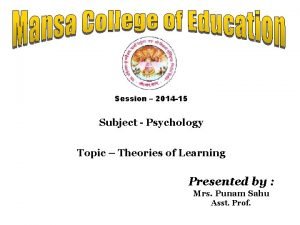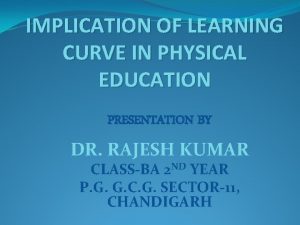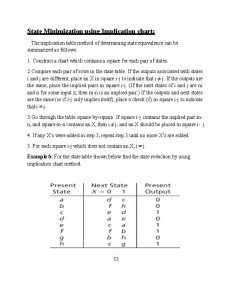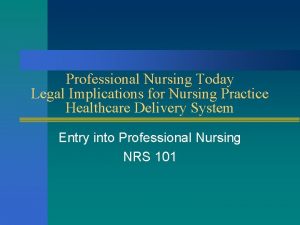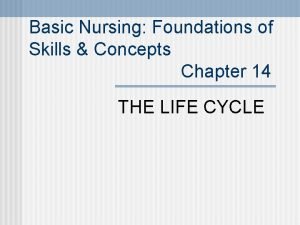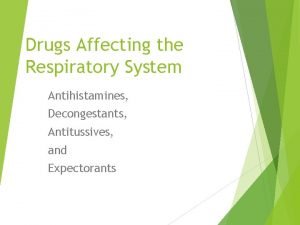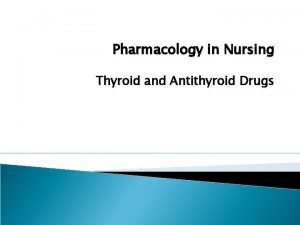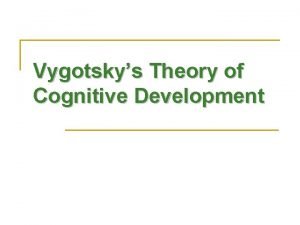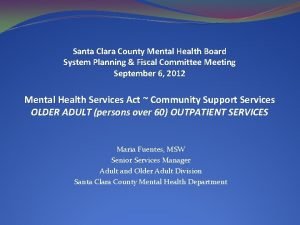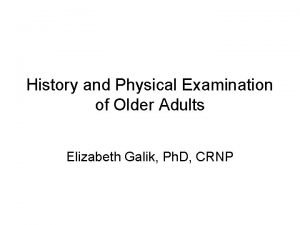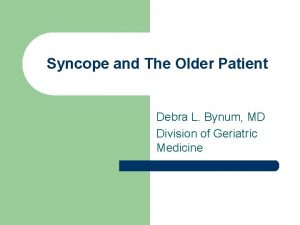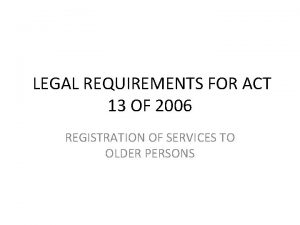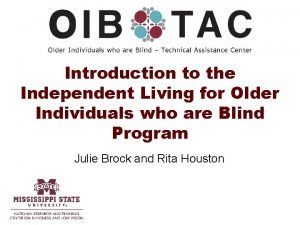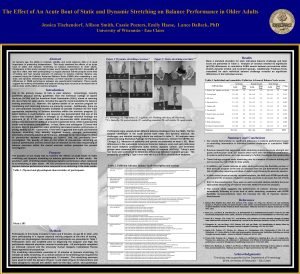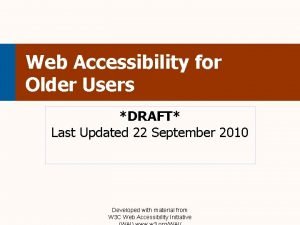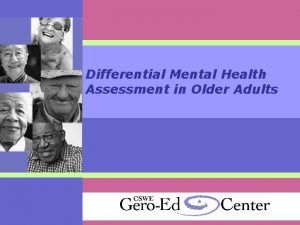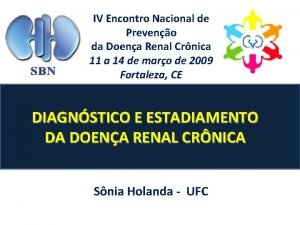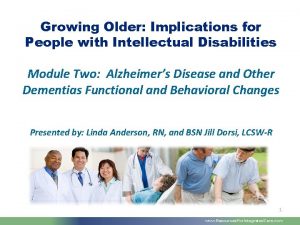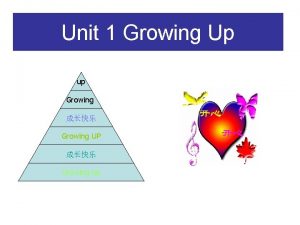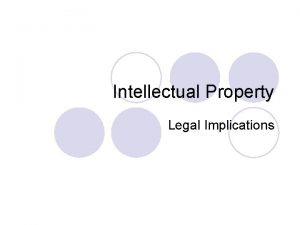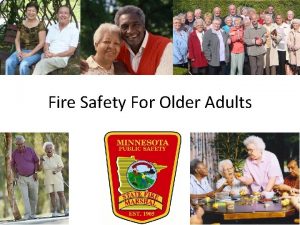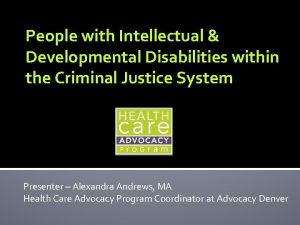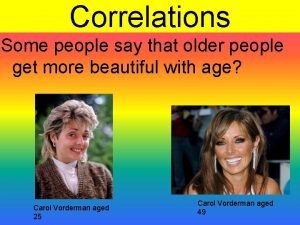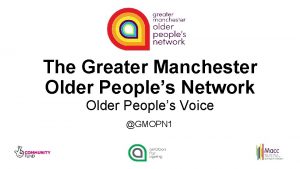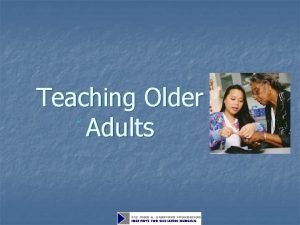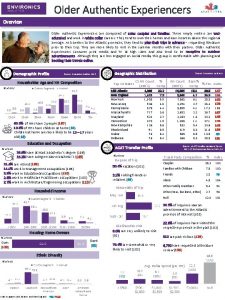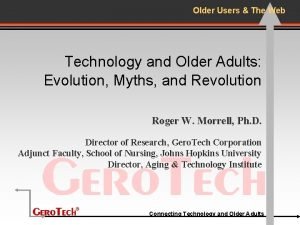Growing Older Implications for People with Intellectual Developmental






























































































- Slides: 94

Growing Older: Implications for People with Intellectual & Developmental Disabilities Module One: New Challenges, New Needs Presented by: Linda Anderson, RN, BSN Jill Dorsi, LCSW-R 1 www. Resources. For. Integrated. Care. com

Introductions & Housekeeping Growing Older, Module One: New Challenges, New Needs is an overview of aging issues encountered by individuals with ID/DD. It is designed to provide concrete information about the aging process in individuals with ID/DD and offer suggestions around developing supports with an individualized, person-centered focus. 2 www. Resources. For. Integrated. Care. com

Module One: Learning Objectives ■ Become familiar with the common physical, cognitive & behavior changes of aging across all populations ■ Examine how aging processes may manifest differently in individuals with intellectual & developmental disabilities (ID/DD) ■ Explore how past medical interventions, including use of psychotropic medications, can contribute to age-related health and behavioral issues for people with ID/DD ■ Become familiar with aging challenges specifically relevant for individuals with Down Syndrome, Seizure Disorders, and Fragile X Syndrome, Autism Spectrum Disorders ■ Consider aging supports and services within the context of assuring personcenteredness, self-determination and personal autonomy 3 www. Resources. For. Integrated. Care. com

Aging Happens to Everyone ■ ■ Natural process that cannot be avoided or reversed Not a disease that can be avoided or cured Getting older presents special challenges “Aging gracefully” is possible 4 www. Resources. For. Integrated. Care. com

Aging is classified in different ways: ■ Primary aging: normal aging -- disease free across the lifespan ■ Secondary aging: changes related to disease and poor health practices ■ Tertiary aging: rapid loss of function occurs shortly before death 5 www. Resources. For. Integrated. Care. com

How does getting older change us? ■ Appearance -- wrinkles, gray hair, weight gain, less muscle mass ■ Cognitive: think more slowly -- may take longer to learn new things or to solve problems ■ Social: Isolation may occur as person loses contact with friends/family through changed circumstances, health issues, death ■ Physical: Increased health concerns, risks, and vulnerabilities, vision declines, hearing loss 6 www. Resources. For. Integrated. Care. com

Successful Aging = Aging Gracefully ■ Minimize risks of disease, avoid or prevent diseaserelated disability ■ Maintain physical and mental fitness ■ Continue an active and socially involved lifestyle ■ Develop and pursue mental stimulation to prevent or delay dementias 7 www. Resources. For. Integrated. Care. com

Tools for Aging Gracefully ■ Eat a balanced & healthy diet plus vitamin supplements ■ Maintain a healthy weight ■ Exercise in a regular routine ■ Manage stress and have relaxation time ■ Avoid smoking and alcohol in excess ■ Continue education and lifelong learning ■ Maintain social contacts & nurturing relationships 8 www. Resources. For. Integrated. Care. com

Factors in Aging that can’t be changed… ■ ■ Age Gender Genetics Ethnicity u Individuals with ID/DD encounter additional factors that “can’t be changed” 9 www. Resources. For. Integrated. Care. com

Growing Older for People with Intellectual and Developmental Disabilities Focus: Adapt activities to level of function, maintain community connections, preserve self-determination 10 www. Resources. For. Integrated. Care. com

Definition: Intellectual/ Developmental Disability ■ Intellectual limitation(s) that hinder independent functioning in daily activities such as self-care, communication, work, or education ■ Intellectual limitation(s) developed before the age of 22 & expected to continue indefinitely ■ Result in need for long-term adaptive and/or functional supports My Thinkers Not Working , National Task Group on Intellectual Disabilities & Dementia Practices, 2012 Rehabilitation Research and Training Center on Aging with Developmental Disabilities Resources page 11 www. Resources. For. Integrated. Care. com

Demographics of People with ID/DD ■ Affects approximately 2% of the population of the US ■ In 2000, 641, 000 persons with ID/DD above 60 ■ Life expectancy for people with ID/DD has increased significantly; common life expectancy for all groups is 66 ■ For example: in 1930 average life expectancy for a person with Down Syndrome was 9 years; now it is 60 ■ Life expectancy for people with other etiologies of ID/DD was 20 years, now it is 72 Source: O’Grady, Joseph. Developmental Disabilities and Aging, Encyclopedia of Aging and Public Health, edited by Sana Loue, Martha Sajatovic, 2008. 12 www. Resources. For. Integrated. Care. com

New Challenges, New Needs ■ Increased life expectancy in ID/DD population * ■ Estimated that 6% of adults with ID/DD (possibly 54, 000) will be affected by some form of dementia, requiring enhanced supervision and care * ■ Over 75% of people with ID/DD live at home with family members ■ “Greying” of caretakers: family members & providers are no longer able to provide supports at the same level * ■ Aging individuals may require enhanced residential supports -- barrier-free living situations, more intensive supervision, enriched nursing oversight ■ Individuals with ID/DD benefit from community-based services and supports and institutionalization can be avoided* *(Report of the National Task Group on Intellectual Disabilities & Dementia Practices, 2012) 13 www. Resources. For. Integrated. Care. com

Questions? 14 www. Resources. For. Integrated. Care. com

Syndromes Associated with ID/DD: Implications for Aging 15 www. Resources. For. Integrated. Care. com

Syndromes Associated with ID/DD: Factors in Aging that Can’t Be Changed ■ ■ ■ Down Syndrome Seizure Disorders Autism Spectrum Disorders Fragile X Syndrome Prader-Willi Syndrome 16 www. Resources. For. Integrated. Care. com

Down Syndrome ■ Most common chromosomal abnormality leading to intellectual disability ■ Results from 3 different genotypes: free trisomy 21 (3 copies of 21 st chromosome), mosaic Down syndrome(some cells are trisomic), translocation Down syndrome (duplication of 21 st chromosome) ■ Tend to experience atypical lifespan development, with increase in anatomic, immunologic, neurological, endocrine, and metabolic disorders ■ Higher age specific mortality risk than people with other intellectual disabilities 17 www. Resources. For. Integrated. Care. com

Complications of Aging in People with Down Syndrome ■ People with Down Syndrome are living beyond 65, with an increased risk of Alzheimer’s with memory loss as first symptom of dementia (particularly short term memory loss) ■ Difficulties with perception may increase falling (may need walking assistance) ■ Congenital cardiac problems/ hypertension ■ Pre-existing cognitive deficits, combined with earlier dementias can change language abilities for both speech and comprehension 18 www. Resources. For. Integrated. Care. com

Complications of Aging in People with Down Syndrome, con’t. ■ Incontinence may be related to renal involvement or dementia related changes in ADL skills ■ Increased incidence of seizures ■ Increased incidence of hypothyroidism, folate or B 12 deficiency ■ Sleep disturbances, depressions, sensory loss ■ Important to screen to differentiate dementia from other age related illness 19 www. Resources. For. Integrated. Care. com

Fragile X Syndrome and Symptoms ■ Genetic condition involving changes in x chromosome with intellectual disability (more frequent in boys) ■ FMR 1 gene makes protein for brain growth with defect resulting in too little or none ■ Associated behaviors: hand biting, hyperactive impulsive behaviors, hand clapping, tendency to avoid eye contact ■ Symptoms: delay in motor skills, speech delay, intellectual disability, large body size, low muscle tone, long face, prominent jaw 20 www. Resources. For. Integrated. Care. com

Medical Complications of Aging in People with Fragile X ■ Fragile X associated tremor ataxia syndrome (FXTAS) —a neurodegenerative disorder ■ Most frequent medical problems: increase in neurological problems with age, gastrointestinal problems, obesity, hypertension, and cardiac problems ■ Movement disorders higher in males than females ■ Need for early screening for FXS-associated medical problems for effective treatment 21 www. Resources. For. Integrated. Care. com

Cerebral Palsy ■ A non-progressive neuro-developmental condition ■ Initiated early in life and persists through adulthood ■ More individuals with Cerebral Palsy are living into adulthood as a result of increased survival of low birth weight infants 22 www. Resources. For. Integrated. Care. com

Aging and Cerebral Palsy ■ Chronic immobility results in increased musculoskeletal problems: decreased bone health, increased fracture rate, increased incidence of arthritis, contractures ■ Ambulation challenges increase with age -- person becomes fatigued more easily & mobility is more difficult ■ Spasticity and movement disorders may increase ■ Already impaired muscle function may deteriorate further due to aging process 23 www. Resources. For. Integrated. Care. com

Autism Spectrum Disorders ■ Developmental disorder that appears in first 3 years of life ■ Affects development of “normal” social and communication skills ■ Etiology of autism remains unknown but increase noted in people with Fragile X, and more common in families with history of autism ■ Individuals demonstrate a wide range of functional skills and abilities 24 www. Resources. For. Integrated. Care. com

Aging Adults with Autism ■ Lifespan outcomes with Autism are unpredictable: some improve, some plateau, some lose skills ■ People with ASD have an increased risk of seizures, accidental deaths (drowning, suffocation), earlier death from heart disease, aspiration pneumonia ■ Restrictive behaviors such as ritualistic, compulsive or self injurious behaviors tend to become more infrequent with age ■ Those with language skills and less impairment of social interaction often do better across their lifespan ■ Early intervention with speech, OT, and PT as well as meds and behavior plans improves lifespan outcomes 25 www. Resources. For. Integrated. Care. com

Aging Challenges for People with ASD ■ No specific aging issues associated with people with autism at this time ■ More research on aging adults with ASD is necessary (most research focuses on younger people) ■ Inflexibility and difficulty adjusting to changes may create significant challenges for individuals when they must cope with new needs & living situations ■ Some individuals with ASD become more comfortable with changes in their lives and develop improved coping skills 26 www. Resources. For. Integrated. Care. com

Seizure Disorders ■ Seizures occur when the electrical system of the brain malfunctions, uncontrolled discharge of electrical energy in the brain resulting in unconsciousness , muscle contractions ■ Type depends on part and how much of brain involved by electrical disturbance ■ Generalized seizures( absence, atonic, tonic-clonic) ■ Partial (simple and complex) 27 www. Resources. For. Integrated. Care. com

Seizure activity over many years takes its toll: ■ Long-term treatments of seizure disorders frequently create additional challenges for people as they age ■ Some people experience cognitive decline and atrophy of the brain ■ Anti-epileptic medication: benefits with risks -- decrease in seizure activity but serious implications for individuals as they age 28 www. Resources. For. Integrated. Care. com

More on Aging and Seizure Disorders ■ Some anti-epileptic medications affect cholesterol, folate, glucose metabolism, and sodium levels adversely ■ Increased risk of accelerated cognitive and brain aging as a result of seizures ■ Risk of vascular disease increases as a result of physical inactivity ■ Frequent falls during seizures may cause fractures that seriously impact a person’s mobility as he/she ages 29 www. Resources. For. Integrated. Care. com

Prader–Willi Syndrome (PWS) ■ Abnormality on the 15 th chromosome ■ Most common life threatening genetic cause of obesity in children ■ PWS typically causes low muscle tone, short stature, incomplete sexual development, chronic feeling of hunger (hyperphagia) & slow metabolism leading to obesity, borderline, low IQ ■ Motor development delays ■ Small hands and feet ■ May have behavior problems and psychiatric disorders 30 www. Resources. For. Integrated. Care. com

Aging in Prader-Willi Syndrome ■ Biggest factor: morbid obesity (if weight is uncontrolled) can lead to type 2 diabetes, hypertension, joint and lung problems ■ Premature aging with age related physical morbidity and functional decline ■ Increased cardiovascular disease -- frequently right sided heart failure ■ Increased incidence of knee and hip problems (often require joint replacements) ■ Increase incidence of dermatological problems 31 www. Resources. For. Integrated. Care. com

Questions so far? 32 www. Resources. For. Integrated. Care. com

Long-Term Medications & Common Side Effects Implications for Aging Individuals 33 www. Resources. For. Integrated. Care. com

Effects of Long-term Medication Use ■ Medications may be considered inappropriate when their risks outweigh their benefits ■ Excessive use of psychotropic medications and anti-epileptic medications (AEDs) can expose people to adverse side effects ■ May lead to deterioration of medical and cognitive status ■ Need to protect people from possible meds used as physical or chemical restraints, avoid poly-pharmacy 34 www. Resources. For. Integrated. Care. com

Medications Commonly Prescribed for People with ID/DD ■ ■ Anti-Psychotic Medications Anti-epileptic Medications Anxiolytics (Anti-Anxiety Medications) Hypnotics 35 www. Resources. For. Integrated. Care. com

What are Anti-psychotics? ■ Class of meds used to treat psychosis and other mental or emotional conditions ■ Block release of dopamine in the brain ■ Typical (conventional) or atypical ■ Typical are not selective and also block receptors in other areas of the brain which may produce unwanted side effects ■ Atypical cause fewer acute or chronic extra-pyramidal symptoms (EPS) ■ Atypical antipsychotics result in improvement in mood and cognition compared to typical antipsychotics 36 www. Resources. For. Integrated. Care. com

Typical Anti-psychotic Side Effects ■ Extra Pyramidal Symptoms (EPS): acute dystonia (muscle spasms of eyes, neck and tongue), akathesia (inability to remain motionless), akinesia (inability to initiate movement) ■ Tardive Dyskinesia (TD): involuntary movements of face, lips, torso and legs ■ Additional Side-effects: Parkinsonism, depressed mood, low WBC, high prolactin, seizures, impotence, weight gain, dry mouth, rapid heart rate, life threatening neuroleptic malignant syndrome (NMS) -- autonomic system instability 37 www. Resources. For. Integrated. Care. com

Recognizing the Differences between Med-induced Movement Disorders ■ Extra Pyramidal System: voluntary movement system of CNS which regulates muscle tone, posture & body movement ■ Extra Pyramidal Symptoms may include tremors, dystonia (muscle contractions), akinesia (reduced muscle movement), akathisia (restlessness, can’t sit still) ■ Result from dopamine blockage from Typical Antipsychotics ■ Treatment with anticholinergic drugs such as cogentin 38 www. Resources. For. Integrated. Care. com

Tardive Dyskinesia (TD) ■ Syndrome of symptoms characterized by bizarre facial and tongue movements, stiff neck, and difficulty swallowing ■ Result of dopamine blockage of Typical Antipsychotics ■ Treatment is to discontinue antipsychotic ■ Often Not Reversible! 39 www. Resources. For. Integrated. Care. com

Abnormal Involuntary Movement Scale (AIMS) ■ Records the occurrence of Tardive Dyskinesia (TD) in people receiving neuroleptic meds ■ Test is used to detect TD and monitor severity over time ■ AIMS is a global rating method used to observe and rate movement disturbances ■ See handout of questions and movement scale 40 www. Resources. For. Integrated. Care. com

Neuroleptic Malignant Syndrome (NMS) ■ NMS can be fatal—it is rare but life threatening ■ Symptoms: fever, parkinsonian muscle rigidity, tachycardia, fluctuating blood pressure, diaphoresis, rapid deterioration of mental status to coma ■ Caused by Typical Anti-psychotics ■ Treatment: discontinue anti-psychotic immediately and monitor muscle rigidity 41 www. Resources. For. Integrated. Care. com

Additional Movement Disorders ■ Anticholinergic side effects: dry mouth, blurred vision, constipation, urine retention, confusion, tachycardia ■ Caused by acetylcholine blockage ■ Treatment : discontinue anticholinergic med 42 www. Resources. For. Integrated. Care. com

Typical (Older Generation) Psychotropic Meds ■ ■ ■ ■ Haldol Thorazine Mellaril Prolixin Stelazine Navane Moban Older generation meds: higher incidence of EPS & TD 43 www. Resources. For. Integrated. Care. com

Atypical Anti-psychotics (New Generation) ■ ■ ■ Clozaril Zyprexa Seroquel Abilify Geodon Risperdal 44 www. Resources. For. Integrated. Care. com

Atypical Anti-psychotic Side Effects—More Cardiac Issues Less EPS & TD Predisposition to arrythmias Deep vein thrombosis (DVT’s) Increased risk of aspiration pneumonia: swallowing issues concurrent with age & meds & ID/DD ■ Elevated blood sugar: leads to diabetes ■ Increased risk of CVA or pulmonary embolism ■ Increased fall risk ■ ■ 45 www. Resources. For. Integrated. Care. com

Monitoring Atypical Anti-Psychotics ■ ■ ■ ■ AIMS (Abnormal Involuntary Movement scale) EKG CBC Lipid/Liver Function tests Monitor weight Fasting Glucose Monitor for seizures or NMS (Neuroleptic Malignant syndrome) 46 www. Resources. For. Integrated. Care. com

Effects of Age-Related Changes & Medications ■ Age-related changes: altered absorption, changes in hepatic metabolism, reduced renal excretion, altered neurophysiology ■ Age related risks: orthostatic hypotension, increased fall risk, increased fracture risks, osteoporosis ■ Combination of polypharmacy, co-morbid medical conditions, side effects of medications can increase risks 47 www. Resources. For. Integrated. Care. com

Anxiolytics (Anti-Anxiety Medications) Commonly prescribed Benzodiazepines: ■ Xanax ■ Ativan ■ Valium ■ Klonopin ■ Restoril 48 www. Resources. For. Integrated. Care. com

Risks of Anxiolytic (Anti-Anxiety) Meds in Older Adults ■ Benzodiazepines are typically poor choices for the elderly -- need smaller doses ■ Increased magnitude of side effects-- particularly sedation, memory and psychomotor impairments ■ May be due to reduced rate of drug clearance in older adults ■ May experience paradoxical excitement, sleep patterns worsen ■ Over-sedation can result in more falls or fractures ■ Long term use may contribute to cognitive decline or addiction 49 www. Resources. For. Integrated. Care. com

Hypnotic Medications Frequently prescribed for insomnia, these include: Ambien u Lunesta u Sonata u 50 www. Resources. For. Integrated. Care. com

Risks of Hypnotic Meds ■ Not recommended for long-term use ■ May have reverse (paradoxical) reaction in older adults ■ Can be associated with delirium and anticholinergic side effects ■ Additional potential side effects include excessive sedation, morning hangover, increased risk of falls and fractures 51 www. Resources. For. Integrated. Care. com

Anti-epileptic Medications (AEDs) All anti-epileptic drugs act as anticonvulsants -- commonly prescribed AEDs: u u u Depakote Dilantin Tegretol Mysoline Lamictal Neurontin 52 www. Resources. For. Integrated. Care. com

Anti-Epileptic Drugs (AEDs): Benefits & Risks ■ Newer AEDs are better tolerated in elderly, often cause less sedation and require less monitoring ■ AEDs are known to increase the risk of suicidal thoughts and need to monitor for signs of depression ■ Need to prescribe for specific type of seizures 53 www. Resources. For. Integrated. Care. com

Potential Adverse Effects of AEDs ■ Drowsiness, tremors, impaired cognitive skills, hyponatremia, coordination problems ■ May inhibit or stimulate liver metabolism ■ Gum disease (dilantin) ■ Bone loss from long term therapy ■ Serious skin reactions such as epidermal necrolysis ■ Low WBC, visual disturbances, agitation 54 www. Resources. For. Integrated. Care. com

More Concerns for Aging Individuals Using AEDs ■ Some age related changes affect absorption and excretion of meds ■ Reduction in drug clearance can result in overly high serum concentrations (smaller amounts may be therapeutic in elderly) ■ Need to monitor for interactions with other meds; for example, antacids decrease absorption of dilantin ■ Dilantin and tegretol may reduce level of coumadin 55 www. Resources. For. Integrated. Care. com

Other Common Medications: Digoxin, Warfarin, Insulin ■ Medications requiring monitoring in adults over 65: digoxin, insulin, warfarin ■ Account for 41% of drug-related hospitalizations for people over 65 ■ Issues related to use of these medications are behind most frequent emergency room visits 56 www. Resources. For. Integrated. Care. com

Even Common Medications Require Caution ■ Aging makes everyone more prone to side effects ■ Any symptom in any elderly person should be considered a side effect until proven otherwise ■ Don’t dismiss new or sudden changes as being part of a person’s intellectual disability ■ Meds that are not used appropriately, effectively and safely can have devastating consequences ■ Important to know the people you work with -- what is the person’s “baseline”? 57 www. Resources. For. Integrated. Care. com

Prevention of Medication-Related Problems ■ Medication side effects directly impact daily functioning of elderly or disabled ■ Monitor for symptoms such as lethargy, confusion, depression, insomnia, incontinence, loss of appetite, falls, fractures, speech or memory changes ■ Monitor for need for new meds: pain and depression often go undiagnosed and untreated leading to decline in function and participation in social activities 58 www. Resources. For. Integrated. Care. com

Prevention of Med-Related Problems (cont. ) ■ Monitor for unnecessary meds as medical problems change ■ Avoid problems from the wrong med choice (inappropriate dose, condition not responsive to med or a more effective med becomes available) ■ Elderly individuals are more sensitive to CNS side effects of many medications - be alert to oversedation, agitation, sudden changes in mental status 59 www. Resources. For. Integrated. Care. com

Non-Pharmacological Interventions ■ Due to vulnerability to adverse effects of meds, alternatives should be considered to address anxiety or insomnia: ■ Decrease afternoon caffeine intake ■ Exercise regularly, avoid naps ■ Treat nocturia ■ Treat nighttime pain ■ Create a comfortable bedroom environment 60 www. Resources. For. Integrated. Care. com

Questions? 61 www. Resources. For. Integrated. Care. com

Dementia Additional Challenges for People with ID/DD, Caregivers, & Communities 62 www. Resources. For. Integrated. Care. com

What is Dementia? ■ A group of symptoms that accompany certain diseases and physical conditions ■ Loss of intellectual functions severe enough to interfere with ADL’s ■ Affects memory, thinking, language, judgment, and behavior ■ Cause and rate of progression of dementia varies depending on multiple factors 63 www. Resources. For. Integrated. Care. com

Normal Memory Changes ■ May complain about memory loss but still able to recall occasional forgetfulness ■ Occasionally may search for a word or name ■ May have to think about directions but not getting lost in familiar places ■ Remembers important events/ able to carry on conversations ■ Social skills intact www. helpguide. org/alzheimers 64 www. Resources. For. Integrated. Care. com

Memory changes in Dementia ■ May complain of memory loss if asked but not recognizing the loss ■ Frequent word finding difficulties, may ask for items by function not name ■ Gets lost in familiar places & needs extra time to get home ■ Reduced ability to converse ■ Loss of interest in social activities & may behave inappropriately www. helpguide. org/alzheimers 65 www. Resources. For. Integrated. Care. com

Common Issues Associated with Dementia ■ ■ ■ ■ Memory loss Difficulty completing multistep tasks Unable to navigate previously familiar places Reduced judgment skills Personality changes and loss of social skills Taking longer to do more difficult mental tasks Language problems such as difficulties with names of familiar objects 66 www. Resources. For. Integrated. Care. com

Is it dementia or just memory loss? Dementia Self Test ■ Questionnaire not a definitive Guide to diagnosing mild cognitive impairment or Alzheimer’s disease but a tool for self testing for a need for further assessment ■ Try self test: www. helpguide. org/alzheimers 67 www. Resources. For. Integrated. Care. com

Normal Changes vs. Alzheimer's Normal Early Alzheimer’s Disease Can’t find your keys Routinely place important items in odd places, such as keys in the fridge, wallet in the dishwasher Search for casual names and words Forget names of family members and common objects, or substitute words with inappropriate ones Briefly forget conversation details Frequently forget entire conversations Feel the cold more Dress regardless of the weather, wear several skirts on a warm day, or shorts in a snow storm Can’t find a recipe Can’t follow recipe directions Forget to record a check Can no longer manage checkbook, balance figures, solve problems, or think abstractly Cancel a date with friends Withdraw from usual interests and activities, sit in front of the TV for hours, sleep far more than usual Make an occasional wrong turn Get lost in familiar places, don’t remember how you got there or how to get home Feel occasionally sad Experience rapid mood swings, from tears to rage, for no discernible reason Source: www. helpguide. org/alzheimers 68 www. Resources. For. Integrated. Care. com

Functional Capabilities Change ■ Person loses skills in areas where he/she used to function well ■ Person may need a longer time to respond to conversation and situations ■ Personality changes may occur and lead to depression ■ Person may not be able to find favorite objects or clothes ■ Person may become easily upset, confused or short-tempered 69 www. Resources. For. Integrated. Care. com

Some Changes May Become Severe ■ Person may become paranoid or distrustful of familiar places or activities ■ Sudden mood changes leading to explosive emotions or aggressive behaviors ■ Disorganized and frustrated when unable to find favorite objects ■ Person may begin to lose language skills 70 www. Resources. For. Integrated. Care. com

What can you do? ■ Learn about differences encountered when working with adults with ID/DD and dementia ■ Support individuals to maintain connections to others in the community ■ Provide ongoing opportunities to stimulate the person’s interests and memory ■ Seek out resources to design activities for adults with ID/DD and dementia 71 www. Resources. For. Integrated. Care. com

Questions/Discussion 72 www. Resources. For. Integrated. Care. com

Supporting the Person’s Choices Aging Individuals, Autonomy, and Self-Determination 73 www. Resources. For. Integrated. Care. com

Valued Outcomes in Aging ■ Maintain physical and mental health ■ Maintain the ability to function optimally as long as possible ■ Engage actively in life through friendships, contributing to society, and participating in one’s community ■ Continue to pursue interests, hobbies, and enjoyable activities Citation: Heller, T. , Stafford, P. , Davis, L. A. , Sedlezky, L. , & Gaylord, V. (Eds. ). (Winter 2010). Impact: Feature Issue on Aging and People with Intellectual and Developmental Disabilities, 23(1). [Minneapolis: University of Minnesota, Institute on Community Integration]. Retrieved from the Web site of the Institute on Community Integration, University of Minnesota http: //ici. umn. edu/products/impact/231 74 www. Resources. For. Integrated. Care. com

Aging in Place ■ Identify rehabilitation and environmental supports in the community that can accommodate individual’s need for more intensive care ■ Consider Day Programs: often provide valuable stimulation and important connections to friends but must also assure essential environmental supports and ongoing oversight for safety ■ Caregivers and family may need additional training to understand implications of age and progression of dementia SOURCE: Frontline, 2005 SUNY Albany 75 www. Resources. For. Integrated. Care. com

Principles of Self Determination ■ Freedom: to plan a real life: exercise the same rights as all citizens ■ Authority: over resources ■ Support: to build a life in the community of choice, to choose caregivers who will offer support ■ Responsibility: to be fiscally responsible & to contribute to one’s community in a meaningful way www. independentliving. org 76 www. Resources. For. Integrated. Care. com

Assuring Person-Centeredness and Self. Determination ■ Support individuals to consider and discuss their choices around aging before it becomes a crisis ■ Discuss where they would like to live and with whom ■ Don’t be afraid to explore the realities of arranging care: help the person to be pragmatic and to acknowledge barriers, such as aging parents who can no longer provide care ■ Work with the person to identify alternatives if “first choices” are not possible 77 www. Resources. For. Integrated. Care. com

Where to begin? Demystify the aging process through straightforward conversations with the person and his/her caregivers: ■ Talk about how aging is affecting individuals—changes in appearance, health, stamina, thought processes ■ Initiate discussions around the individual’s wishes for developing new supports/living arrangements to manage agerelated needs ■ Encourage caregivers to discuss their concerns and plans honestly and openly 78 www. Resources. For. Integrated. Care. com

Topics to Discuss ■ Where do you want to live - in a small house, with family, with friends? ■ What things are most important for you where you live? (own room, familiar people, access to shopping, TV, etc) ■ Who are your closest friends? How important is it to you to have them visit you often? ■ What other things do you like? Music? Crafts? Video games? TV? Going to yard sales? Concerts? Movies? ■ What do you want to do during the day? Continue to work as long as possible? Develop a retirement plan? 79 www. Resources. For. Integrated. Care. com

Conversations with Caregivers ■ As caregivers age, they may no longer be able to provide a previous level of support ■ Encourage family caregivers to identify their personal goals for retirement and health care ■ Discuss their plans for their family member’s care - who will care for this person in their absence? ■ Help family caregivers to develop a “wish list” for their family member and help them to prioritize and actualize these wishes ■ Collaborate to identify community resources to make their plans and wishes reality Aiding Older Caregivers, www. albany. edu/aging/IDD 80 www. Resources. For. Integrated. Care. com

What else can you do? ■ Become as knowledgeable as possible about the aging process for people with ID/DD ■ Research available supports for the aging in your community and through state and federal programs ■ Develop partnerships with community health providers ■ Include individuals and caregivers in conversations around aging and needs for new and different supports ■ Assure that the person’s wishes are known and form the basis of decisions 81 www. Resources. For. Integrated. Care. com

Protect the Person’s Autonomy ■ Document what the person identifies as most important - make sure this information is considered as part of planning ■ Share the information with health professionals, day program providers, case workers, family members (as long as the person has given consent) ■ Develop partnerships and alliances wherever and whenever possible—share information, discuss resources ■ Make the person’s continued autonomy a priority 82 www. Resources. For. Integrated. Care. com

Advocacy is Essential Assure that people working with individuals with ID/DD in healthcare settings understand who the person is: u u u How does the person communicate? What are his/her capabilities? How does he/she communicate his/her needs? What does he/she need help with? Toileting, dressing, eating? Special diet needs and preferences? What does he/she need to feel safe and confident? 83 www. Resources. For. Integrated. Care. com

Learn about Public Initiatives & Resources for Aging Individuals ■ Affordable Care Act (ACA) ■ Olmstead Decision - What is your state’s Olmstead Plan? ■ Aging Services: supports for senior citizens that allow individuals to receive ”mainstream” aging services as well specialty services for ID/DD ■ Aging and Disability Resource Centers (“ADRCs”) 84 www. Resources. For. Integrated. Care. com

Be Informed ■ Read up on current research and initiatives for people with ID/DD who are aging ■ Explore state and federal websites for information on resources, funding, and supports for people aging with disabilities 85 www. Resources. For. Integrated. Care. com

Some Case Examples ■ Daisy and Levaquan: an age-related reaction to a common antibiotic ■ Robert, hospitalized for pneumonia, able to feed himself but was afraid to self-advocate ■ DJ, challenged with cerebral palsy, did not have access to the buzzer to ask for toileting assistance 86 www. Resources. For. Integrated. Care. com

Aging Doesn’t Change Who the Person Is ■ Person who is aging still treasures hopes, dreams, and connections to family and friends ■ Assure that the person is included in developing and considering new and enhanced supports ■ Person-centered planning and principles of selfdetermination are the foundation for the plan and the person 87 www. Resources. For. Integrated. Care. com

Useful Websites ■ Rehabilitation Research and Training Center on Aging with Developmental Disabilities: Maintained at the University of Illinois at Chicago, includes resources such as a bibliography on dementia care, fact sheets and background materials, assessment tools and instruments, links to dementia reports and guidelines, information on meetings, conferences, and workshops, contact information for researchers in these fields. www. rrtcadd. org ■ School of Social Welfare, University at Albany, State University of New York (SUNY), Intellectual Disabilities, Aging, and Dementia: A website dedicated to providing resources for staff caring for aging individuals with intellectual disabilities. Includes links to assessment tools, research articles, training opportunities, and other useful information and supports. http: //www. albany. edu/aging/IDD/r-id. htm 88 www. Resources. For. Integrated. Care. com

Websites (cont. ) ■ Institute on Aging, University of Wisconsin – Madison: Provides resources, articles, and research on policies and practices in health care for the aging http: //aging. wisc. edu ■ Institute on Community Integration, UCEDD, University of Minnesota: Offers resources, information and training opportunities for individuals with intellectual disabilities and their families and caregivers. Information and opportunities for services, education, and consultation services. www. ici. umn. edu 89 www. Resources. For. Integrated. Care. com

Post Test: True or False? 1. Aging is classified in different ways: primary, secondary, tertiary T / F 2. Gender and genetics are unmodifiable factors in aging. T / F 3. A normal memory change is characterized by acknowledging memory loss when asked about but not being aware of any loss in daily life. T / F 4. Down’s Syndrome is the most common chromosomal abnormality leading to I. D. T/F 5. Aging makes us less prone to medication side effects. T / F 90 www. Resources. For. Integrated. Care. com

Post Test: con’t 6. Chronic immobility increases musculoskeletal problems. T / F 7. Individuals with ID/DD maintain the same level of need for residential supports across their lifetimes. T/F 8. People with ID/DD are usually good self-reporters. T/F 9. Excessive use of psychotropic and AED meds in the ID/DD population creates additional vulnerabilities as people age. T/F 10. Life expectancy of people with ID/DD is declining. T/F 91 www. Resources. For. Integrated. Care. com

Answers to Post-Test A and B Post Test A 1. True 2. True 3. False 4. True 5. False Post Test B 1. True 2. False 3. False 4. True 5. False How Did You Do? 92 www. Resources. For. Integrated. Care. com

Discussion & Questions 93 www. Resources. For. Integrated. Care. com

Thank you for your time!! 94 www. Resources. For. Integrated. Care. com
 Life is older older than the trees
Life is older older than the trees Medical implications of developmental biology
Medical implications of developmental biology The wild swans at coole techniques
The wild swans at coole techniques Cost growing older
Cost growing older The virtues of growing older
The virtues of growing older Late adulthood cognitive development
Late adulthood cognitive development Chapter 50 intellectual and developmental disabilities
Chapter 50 intellectual and developmental disabilities As people grow older
As people grow older Implications of nativist theory
Implications of nativist theory Math
Math Chronotropic drugs
Chronotropic drugs Database approach to data management
Database approach to data management Novolin n dosage chart
Novolin n dosage chart Social implications of computers
Social implications of computers Bandura social learning theory 1971
Bandura social learning theory 1971 Capsofungin
Capsofungin Who is the “father of personal identification”?
Who is the “father of personal identification”? What is legal implications
What is legal implications Implikasi etis
Implikasi etis Philosophies of education
Philosophies of education Legal implications of nursing documentation
Legal implications of nursing documentation Chapter 23 legal implications in nursing practice
Chapter 23 legal implications in nursing practice Constructive tools examples
Constructive tools examples S-r bond theory
S-r bond theory Legal implications of social media
Legal implications of social media How audience negotiate meaning in mil
How audience negotiate meaning in mil Nietzsche existentialism
Nietzsche existentialism Learning curve in physical education
Learning curve in physical education Marketing implications
Marketing implications Future implications definition
Future implications definition Ranexa nursing implications
Ranexa nursing implications Implication table state minimization
Implication table state minimization Discussion and implications
Discussion and implications Implications of nativist theory
Implications of nativist theory Tautological implication
Tautological implication Marketing implications
Marketing implications Legal implications in nursing practice
Legal implications in nursing practice Implications of quantum entanglement
Implications of quantum entanglement Nursing implications
Nursing implications Examples of decongestants
Examples of decongestants Nursing implications for synthroid
Nursing implications for synthroid Guided participation vygotsky
Guided participation vygotsky Older adults mental health
Older adults mental health Conclusion of physical examination
Conclusion of physical examination Syncope in the older patient is
Syncope in the older patient is Dq98 assessment form
Dq98 assessment form Pseudostratified vs simple columnar
Pseudostratified vs simple columnar Ajayan is ten years older than vijayan
Ajayan is ten years older than vijayan Which sentence tells you that hoa is older than nien
Which sentence tells you that hoa is older than nien Juan continued playing although he injured his knee
Juan continued playing although he injured his knee Older women's cohousing
Older women's cohousing Superlative de older
Superlative de older Downsizing and divesting older business
Downsizing and divesting older business Older individuals who are blind program
Older individuals who are blind program Dynamic stretching for older adults
Dynamic stretching for older adults Module 11 studying the brain and older brain structures
Module 11 studying the brain and older brain structures Covids older adults
Covids older adults The brother of the prodigal son
The brother of the prodigal son Which is older
Which is older Web accessibility for older users
Web accessibility for older users Sos spelling for older students
Sos spelling for older students Sos spelling for older students
Sos spelling for older students Mental health and older adults
Mental health and older adults The breadwinner main character
The breadwinner main character Moses older sister
Moses older sister Nipołomice
Nipołomice Taller and younger and shorter and older
Taller and younger and shorter and older Mental health and older adults
Mental health and older adults Taller younger sister shorter older brother
Taller younger sister shorter older brother Patricia polacco brother
Patricia polacco brother Older adults
Older adults Altered cognition in older adults is commonly attributed to
Altered cognition in older adults is commonly attributed to Patricia polacco husband
Patricia polacco husband Rutin för avvikelsehantering
Rutin för avvikelsehantering Tack för att ni har lyssnat
Tack för att ni har lyssnat Läkarutlåtande för livränta
Läkarutlåtande för livränta Treserva lathund
Treserva lathund Myndigheten för delaktighet
Myndigheten för delaktighet Tack för att ni lyssnade
Tack för att ni lyssnade Mall för debattartikel
Mall för debattartikel Tobinskatten för och nackdelar
Tobinskatten för och nackdelar En lathund för arbete med kontinuitetshantering
En lathund för arbete med kontinuitetshantering Tack för att ni har lyssnat
Tack för att ni har lyssnat Biologiska arvet
Biologiska arvet Byggprocessen steg för steg
Byggprocessen steg för steg Fuktmätningar i betong enlig rbk
Fuktmätningar i betong enlig rbk Tryck formel
Tryck formel Presentera för publik crossboss
Presentera för publik crossboss Kung dog 1611
Kung dog 1611 Förklara densitet för barn
Förklara densitet för barn Nationell inriktning för artificiell intelligens
Nationell inriktning för artificiell intelligens Tack för att ni har lyssnat
Tack för att ni har lyssnat Smärtskolan kunskap för livet
Smärtskolan kunskap för livet Mall för referat
Mall för referat Frger
Frger



